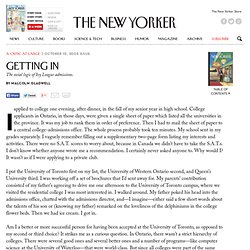

1) The Song Machine - The New Yorker. On a mild Monday afternoon in mid-January, Ester Dean, a songwriter and vocalist, arrived at Roc the Mic Studios, on West Twenty-seventh Street in Manhattan, for the first of five days of songwriting sessions.

Her engineer, Aubry Delaine, whom she calls Big Juice, accompanied her. Dean picked up an iced coffee at a Starbucks on Seventh Avenue, took the elevator up to Roc the Mic, and passed through a lounge that had a pool table covered in taupe-colored felt. Two sets of soundproofed doors led to the control room, a windowless cockpit that might have been the flight deck of a spaceship. Tor Hermansen and Mikkel Eriksen, the team of Norwegian writer-producers professionally known as Stargate, were waiting there for Dean. Both are tall and skinny ectomorphs with pale shaved heads who would not look out of place in a “Matrix” movie. Most of the songs played on Top Forty radio are collaborations between producers like Stargate and “top line” writers like Ester Dean. How did this happen? 2) The Master - The New Yorker.
When I was in high school, at Horace Mann, in the Bronx, in the nineteen-seventies, everyone took pride in the brilliant eccentricity of our teachers.

There was an English teacher who slipped precepts from the Tao Te Ching into his classes on the Bible and occasionally urged us to subvert standardized tests by answering every question with the word “five.” There was a much loved language teacher who would pelt distracted students with a SuperBall. 3) About a Boy - The New Yorker. For high-school seniors like Skylar—who live in prosperous suburbs, have doting parents, attend good schools, and get excellent grades while studding their transcripts with extracurricular activities—the hardest part of the college application is often the personal essay.

They’re typically asked to write about some life-changing experience, and, if their childhood has been blessedly free of drama, they may find themselves staring at a blank screen for a long time. This was not a problem for Skylar. Skylar is a boy, but he was born a girl, and lived as one until the age of fourteen. Skylar would put it differently: he believes that, despite biological appearances, he was a boy all along.
He’d just been burdened with a body that required medical and surgical adjustments so that it could reflect the gender he knew himself to be. Skylar is an F.T.M., or “female-to-male,” transgender person, a category that has been growing in visibility in recent years. Puberty complicated things. 4) Getting In - The New Yorker. There was, first of all, that strange initial reluctance to talk about the matter of college at all—a glance downward, a shuffling of the feet, a mumbled mention of Cambridge.

“Did you go to Harvard?” I would ask. I had just moved to the United States. I didn’t know the rules. An uncomfortable nod would follow. 5) Trial by Twitter - The New Yorker. One Saturday last August, a sixteen year-old girl in West Virginia did something that teen-agers do: she told her parents that she was sleeping at another girl’s house, across the Ohio River, and then, after her mother dropped her off there, she and a few friends headed into the hot summer night to a party.

She brought a bottle of vodka with her, and she used it to spike a slushy that she bought at a gas station on the way to their destination, in a town called Steubenville. At the party, she met up with a sixteen-year-old named Trent Mays, a good-looking, dark-haired football player with whom she’d been flirting by text and tweet. She’d been “talking to him,” a porous term that teen-agers use to refer to a romantic relationship that is unlikely to be exclusive, and can involve spending time together or just courting through social media. A friend of Mays’s named Anthony Craig had also been talking to the girl that summer. 6) Rogue Element - The New Yorker. In June of 2011, Isaac Aguigui and his wife, Deirdre, learned that they were going to have a boy.

Aguigui, then twenty years old and a private in the Army, spoke excitedly with friends about becoming a parent. Deirdre, twenty-three and a sergeant, sent her father a text announcing, “It’s a boy,” repeating the final word eight times to punctuate her glee. They picked out a name, Kalvin James, and when Deirdre adopted an orange tabby they named it Hobbes, evoking the comic strip “Calvin and Hobbes.” The two had met in 2009, as cadet candidates at the U.S. Military Academy Preparatory School for West Point, at Fort Monmouth, New Jersey. Aguigui went to basic training, and then to Fort Huachuca, Arizona, for advanced instruction in military intelligence; Deirdre deployed to Iraq. In July, when Deirdre was five months pregnant, she complained on Facebook of terrible heartburn. 7) Southern Discomfort - The New Yorker. The New Year’s Day vote in Congress that brought a temporary truce to the fiscal wars showed the Republicans to be far more divided than the Democrats, and the division broke along regional lines.

House Republicans from the Far West and from the Northeast favored the Senate’s compromise bill by large margins, and Midwesterners were split; but in the South, Republican opposition was overwhelming, 81–12, accounting for more than half of the total Republican “no” votes. In other words, Republicans outside the South have begun to turn pink, following the political tendencies of the country as a whole, but Southern Republicans, who dominate the Party and its congressional leadership, remain deep scarlet. These numbers reveal something more than the character of today’s Republican Party; a larger historical shift is under way. 8) Miss Lora - The New Yorker. Years later, you would wonder if it hadn’t been for your brother would you have done it?

You’d remember how all the other guys had hated on her—how skinny she was, no culo, no titties, como un palito, but your brother didn’t care. I’d fuck her. You’d fuck anything, someone jeered. And he had given that someone the eye. You make that sound like it’s a bad thing. Your brother. In those last weeks, when he finally became too feeble to run away, he refused to talk to you or your mother. You were at the age where you could fall in love with a girl over an expression, a gesture. That’s what happened with Miss Lora, too. It was 1985. Someone should have medicated you.
Paloma thought you were being ridiculous. 9) Peace In Our Time - The New Yorker. Nearly everyone in Norway owns a cell phone, so when the shooting started on the island of Utøya, at around five o’clock in the afternoon on July 22nd, calls immediately went out.

Panicked teen-agers attending a Labor Party summer camp on the island dialled the Norwegian equivalent of 911 only to find themselves cut off. Operators were reportedly trying to keep the lines open for calls related to the bombing of a government office building in downtown Oslo. 10) Bagman - The New Yorker. “I’ve felt every emotion over the last few days,” Ryan Dziadul said, sitting at his desk in the offices of Jonathan Adler, the homewares designer.

“My immediate reaction was: This was a huge mistake—what have I done?” Dziadul, who is thirty-one and works as Adler’s public-relations manager, shook his head. “Then I was really excited and it felt like an accomplishment.” Bonus) Semicolons; So Tricky - The New Yorker. One of the pleasures of a recent piece on semicolons by Ben Dolnick, in the Times (“Semicolons: A Love Story”), was his reference to William James, whose deft use of the semicolon to pile on clauses, Dolnick writes, is “a way of saying to the reader, who is already holding one bag of groceries, here, I know it’s a lot, but can you take another?”
I like this because it reminds me that I have always meant to read “The Varieties of Religious Experience”; also because it makes the point that we learn how to punctuate by reading. Finally, the image of the grocery bags reinforces the idea that semicolons are all about balance. In college, whenever I used a semicolon in a paper, it came back to me with a big red circle around the offending member. I thought semicolons were just inflated commas, and I realized that I had no idea how to use them, and was afraid it was too late to learn, so I decided to do without them.
Dear MaJa; She likes to think of a semicolon as a comma with vibrato. Bonus) Englishing the Iliad: Grading Four Rival Translations - The New Yorker. This week in the magazine, Daniel Mendelsohn reviews a new version of Homer’s Iliad, translated by Stephen Mitchell. He also discusses the translation and his piece in this week’s Out Loud podcast. A good way of getting a sense of the values and priorities of the Iliad’s many translators is to compare how they translate a given passage.
The best showcases for these comparisons aren’t necessarily the poem’s “big moments” but smaller, more ordinary passages, such as the one I’ve chosen below, lines 795-800 from Book 13. This is one of the dozens of extended similes that Homer uses to convey how a given event looks and feels—in this instance comparing the massed ranks of Trojan troops preparing for battle to waves breaking on a shore during a wild storm at sea.
A reasonably straightforward translation might look like this: